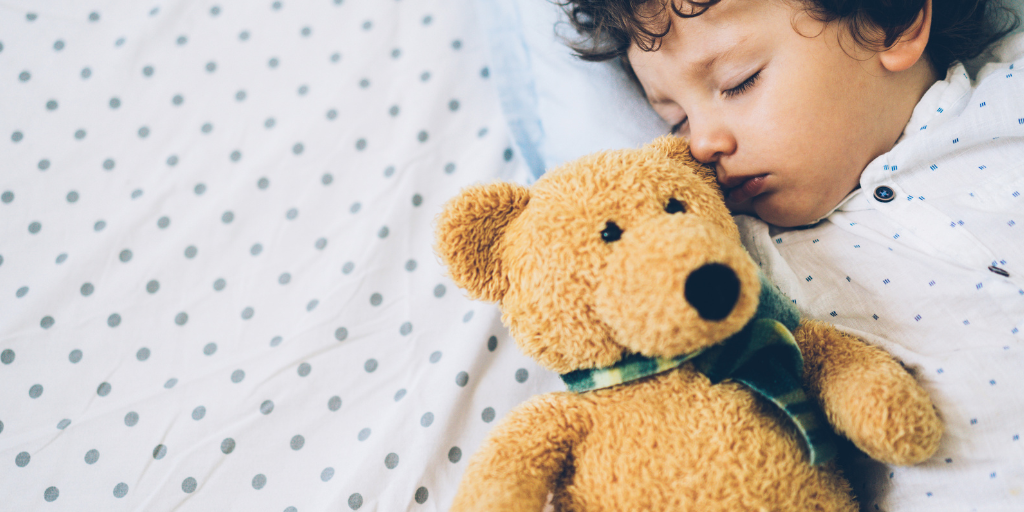Once your little one reaches this stage, things may change again for their sleep patterns. Here are some thoughts you might be having;
- How much sleep should my 18 month old be getting?
- What problems might my little one have with sleeping?
- What is the sleep regression and why does it happen?
If this is you, read on for some answers!
Once you get over the age of one year, your little one should be sleeping around 10-11 hours at night and will either be down to one nap a day, or still sometimes need two. If she is having just the one nap in the daytime, it should be around two hours though each child differs.
It’s still important to keep to a good bedtime routine as much as possible and have a consistent wind-down routine, bath, story and bed. Keep looking for your baby’s sleep cues and offer their usual comforting items and action, such as a repetitive bedtime story, being popped into a sleeping sack and having some gentle music, white noise or womb sounds.
Now that your little one can get up to so much more physically, try to have a good daytime routine too. You may find that after breakfast, you could play some games together, followed by a little quieter time in their playpen while you get on with a few things. Head out to the garden or park, or to an indoor play place if the weather’s bad, for some physical activity to release all that energy they seem to have. Then it’s lunch, followed by a nap.
Afternoons can be a repeat of the above, or you might visit friends or have playdates with some other babies of the same age. Consistency keeps your little one feeling safe and secure and a good routine helps them know what to expect – too much change can be unsettling for your child. Of course, the odd change from routine is not a problem and nor is a family event such as a holiday.
Now that your little one is getting so much bigger, you’ll find that she has definite likes and dislike and will want to choose some things for herself. Now’s a good time to start to allow your child some choice in what is going on in their everyday life. This can be particularly helpful at bedtime, as even babies who struggle to settle down may be easier to calm if they feel that they are in charge – at least a little bit!
Give your baby no more than two or three choices, otherwise you could end up having more problems than you started with. So, have two favourite books ready and perhaps two pairs of pyjamas or sleeping bags and allow your little one to choose which they would prefer. Don’t ask questions to which your child could just say “no” – so instead of “do you want to have a bath?” try “do you want a bath or a story before bed?”
Make sure that all the steps you take area leading towards bedtime and now that your child has a better understanding of language, you can say “it’s time for. Story before you go to sleep” or “how about this story before you snuggle down in your cot?” Giving your child warning of what’s to come I also a great idea and something they are now able to understand. So “now you’re going to have a lovely bubble bath before we read a story and go to sleep.”

Sleep Problems at 18 Months
If they have not done so before, your child may try to climb out of the crib at night and some even manage to do it! Make sure there’s nothing in the crib to climb up on and keep the crib far away from things like curtains and blind cords that could be a hazard. Make sure the mattress is at its lowest level. If your child has managed to get out, place some cushions on the floor to break a fall. Though it’s early to be considering a toddler bed, you might want to as they allow your child to get in and out of bed by themselves – but make sure the room is baby-proofed first and that there are stairgates at the top of the stairs or any drops. Don’t make a huge fuss about it – the last thing you want is for your toddler to realise they can get a reaction, as then she’ll keep doing it! Be firm and calm, tell her she must not climb out and put her back in.
Sleep Regression
Between the ages of 18 and 24 months, your little one may have another sleep regression and this can be quite difficult to manage. Like the four-month regression, it’s due to physical and mental changes happening inside your child’s body and there can be several reasons:
- Teething – the canines and molars start to come through now and this can be painful and cause a slight fever.
- Separation anxiety – your child may worry that you’re not coming back when you leave the room at night. Some babies have this around seven to eight months and it can happen again when they are between 18 months and two years. This can mean they don’t want to go to sleep, or are distressed if they wake at night and you’re not in the room.
- Stronger likes and dislikes – you’ve been teaching your child all these new skills form feeding themselves to playing with stacking blocks and even taking off their shoe. It’s no wonder they start to demonstrate their independence and choosing how, and when, they are going to sleep is just one way they can do that.
How to cope: You now have to introduce an element of discipline when your child starts to do something that’s not helpful in the long term. So saying “no” calmly and firmly when they display bad behaviour, not allowing yourself to be stressed and knowing that this phase will pass, all helps.
Further Reading:
Understanding Your Baby's Sleep From Newborn to 3 Months
Understanding Your Baby's Sleep From 12-18 Months
Baby Sleep Patterns Between 3 and 6 Months




